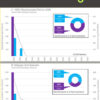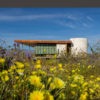1. Built-Out Suburbs
As the multi-nucleated California metropolis spreads out, the built-out suburbs remain, squeezed between physical and social patterns that define the old and new economies. These suburbs sit between the industrial gridscape of the early twentieth century and the newly formed gated communities, tilt-up business parks and infotainment destinations of the ex-urbs. Much like the Victorian neighborhoods that were chastised after World War I and then left for decades slowly to decline, the post-World War II suburb is a frontier for what were previously thought to be exclusively inner-city issues.
I am interested in reconsidering a specific breed of suburb: the production suburbs of the 1950s through 1980s. I base my observations on endless hours of driving through Los Angeles and Orange Counties. Sometimes this wandering was done in the context of municipally-sponsored urban design projects in Anaheim, Santa Ana, and the San Fernando Valley. At other times, observation was structured within the context of teaching a design studio. Often I just drive to places where large tracts of single-family housing are built behind endless miles of commercial strips.
These suburbs have long since shed their “organization man” bedroom-community image. Today, suburbs are places to witness contemporary social dynamics. They are the home of a graying population of small homeowners with a lot of time on their hands. These are the folks who put down their roots and raised their families in the gray-suit 1950s, go-go ’60s, and silent-majority ’70s. Now they go to endless numbers of community meetings.
The suburbs are also the melting pots of twenty-first century California. Monterey Park is Chinatown on steroids. Westminster is Saigon without scooters. Huntington Park is the home of a real as opposed to themed Olivera Street. As new groups assume leadership roles in these communities in development, culture, politics, and education, the vibrancy and tensions of these enclaves are revealed in the same community meetings.
Unlike the inner city neighborhoods of a generation ago, no Jane Jacobs has yet emerged to observe the fine-grained relationships between social interactions and physical form that occurs in these suburbs. Unlike the city with its coterie of academic, professional, and populist boosters who after forty years of effort have reinvigorated our intellectual and development interest in the city—efforts that can be traced back to the publication of The Death and Life of Great American Cities—elite culture has not yet decided to like, much less endorse, the middle landscape of the suburbs.
Despite elite culture’s rejection of suburbia, it is useful to remind ourselves that there are traces of a higher will to order in the suburbs. In the best suburbs, frontage roads parallel thoroughfares, and children are able to walk to local elementary schools without crossing major streets. Abundant parks and shopping nodes are spaced at even, and even walkable, half-mile intervals. A variety of low-density housing types are well integrated with garden apartments and higher density condominiums built on top of parking decks. Still, even those of us who seek these traces of finery admit that the idyllic intentionality of the best suburbs is the exception rather than the rule in most of Southern California. In general, the suburbs of the 1950s through the 1980s are the zones that are the least likely to be held up by architects, critics, city officials, and even residents as interesting or having a “sense of place.”

Revivalists may praise the individual landmarks of the Googie era, but few have anything but negative thoughts for endless super streets with no trees, half vacant strip malls, housing tracts clustered about cul-de-sacs cut off from their surroundings, and overcrowded garden apartments quickly deteriorating into slums. Suburbs are also places with excessive numbers of adult entertainment venues, used car lots, body shops, psychics, tarot card readers, and swap meets. The plethora of these uses in suburbs is often the result of parcelization patterns not in sync with today’s real estate market trends. Narrow and long parcels stretched along strips cannot be assembled into deep lots for the placement of up-to-the-minute big boxes. The big boxes go someplace else. The leftovers are cheap to rent. The suburban streetscape becomes a non-brand, non-chain, no-name landscape, and it frustrates city and community leaders who want to raise the local tax base. This type of suburban environment is the locus for increasing disaffection, particularly when combined with the increasing crime rates associated with overcrowded housing, the frustration of poor schools, and social problems—including racism—formerly identified only with the inner cities.

Since issues previously confined to the inner-city have found their way deep into the sinews of suburbs, it is not surprising that redevelopment scenarios invented for the revitalization of late nineteenth or early twentieth century downtowns are increasingly applied to post-1940s landscapes. The current trend for physical repair of disaffected suburban communities, like the downtowns of the ’60s, favors wholesale clearance. In Brea, the goal is to replace the strip with the small town Main Street adjoined by housing featuring front porches, all wrapped in the styles of yesteryear. In Orange, clearance promotes the hyper-urbanism of the retail entertainment destination. While both of these projects are extraordinarily successful, concepts complementary to the suburban ideal, both formative and yet to be invented, are too often left unexplored in the rush to promulgate global neo-urbanism. Suburban virtues, barely remembered, are at their fashionable nadir.
In the areas I have worked in Anaheim and the San Fernando Valley, I have first and foremost been impressed by the commitment of existing homeowners, business people, and other stakeholders to build upon the affirmative choice of suburban, not neo-urban, lifestyles. They feel that their suburbs are being ruined by out-of-sync and inappropriate development, ignored by city leaders, and disrespected by design and planning consultants who all too often view the suburban ground plane as urban, a place for strategic design and development interventions out of proportion or unsympathetic to the actual situation on the ground. These people, long-term stakeholders as well as recent transplants of all ages, genders, nationalities, and ethnicities, are seeking to tune, or perhaps retune, their communities while maintaining the value choices associated with a suburban sense of place.
As in the inner cities of a generation ago, it is better to consider incremental as opposed to overarching solutions for the repair of suburbs. Unlike in the inner cities, this means accepting as starting points the cul-de-sac planning, separation of pedestrians from vehicles, garden settings, and strip-like linearity of suburbia. At the same time, making suburbs too rich, too neat, too tidy, too organized, and too based upon any set of “Wonder Years” ideals would miss the genius and potential of present suburbs. In the final analysis, the toolbox for suburban revitalization must create a hybrid condition, part garden and part global city.
2. Hybrid Suburbs
To reformulate, revitalize, and reinvent a suburb, one must start with optimistic observation of existing conditions. For instance, rather than define the high vacancy rates of the major thoroughfare strips as under-performing real estate, I find it useful to consider their reuse as entrepreneurial and social incubators. The strip more than any other metropolitan location is now the cutting-edge for mom and pop, artisan, and small businesses. Cities should carefully consider how to encourage these activities in these locations rather than lumping them in with the massage parlors and body shops. Inexpensive major thoroughfare space is also ideally used for institutional and non-profit purposes such as childcare, primary, secondary and higher education centers, and recreational facilities such as boys and girls clubs. Civic uses such as satellite city halls, police and fire stations, libraries, and linear parks can also be accommodated on lots that contemporary retailers reject.
In Anaheim and the San Fernando Valley, the narrow lot depths of typical strip parcels (between 100 and 250 feet), the vast preference for single-family lifestyles, and the need to mitigate high commercial vacancy rates further suggest the introduction of housing on these sites. Production builders and developers including the Olsen Company, Kaufman and Broad, and The Lee Group have already demonstrated the ability to realize densities that approach twenty single-family dwelling units to the net acre on infill sites along major suburban boulevards. These densities double and triple the older suburban patterns realized in the 1950s, coincidentally encourage the introduction of transit, and maintain the essential pattern of daily suburban life.
The City of Anaheim is pursuing the implementation of overlay zoning that encourages these types of residential projects at existing commercial infill sites. At the same time they are seeking means to improve upon the developers’ formulas that are driven mainly by market analysis. Anaheim is gradually implementing design standards that seek to ensure that new housing along major boulevards doesn’t simply tuck behind walls and gates. For example, along South Anaheim Boulevard attached townhomes will be permitted under a new zoning overlay on commercially zoned land. To ensure that the resulting streetscape is more active, entry to individual units in this location will be required to face the street, with garages facing a parallel service alley.
In Anaheim, zoning is being architecturally exploded by three-dimensional considerations. Anaheim imagines greenways of higher density, single-family housing prototypes interspersed with pockets of civic, commercial, and institutional uses. In essence, the suburban boulevard evolves from a single-purpose commercial land use into a hybrid: in plan, a mix of uses within easy walking and biking distance; in section, a mix of higher intensity mixed typologies that better buffer adjacent single-family homes and neighborhoods from the activity of the major streets.
3. Desirable Suburbs
The dream of the suburb is to live in harmony with the outdoors and at the same time enjoy the benefits of city life. Unfortunately, too many suburbs have evolved into single purpose land uses complemented by over-engineering. Yet channelization of arroyos and creeks can be gradually reversed. Ubiquitous power transmission right-of-ways can be safely used as trails and community gardens. Land uses can be redefined to reflect a better mix of residential uses interspersed with a greater complexity of other uses. Given the wide roads, numerous easements, and quiet secondary streets, suburbs are potentially a bicyclist’s everyday paradise, where the concept of the quarter-mile walker’s radius can be complemented by the exponential increase of activities and resources found within the cyclist’s wider sphere of access. In short, the suburbs can be converted into high-quality, physically networked environments with minimal evolution of existing physical frameworks.

Today, planning and design discourse generally rejects suburbs as hopeless examples of low-density waste that should be reformed. Ironically, suburbs’ wasteful lack of density is the enduring pattern that may ensure their long-term vitality. The fact that suburbs offer generous open space resources, most particularly at the scale of the individual house, will never be duplicated in older cities or new communities. At the same time, suburbs will increasingly be seen as conveniently placed between the job-rich inner and outer belts. In essence, suburbs will become desirable again because they offer the amenity of space, the opportunity to design this space, and the consequent lifestyles afforded by this redesigned space.
Suburbs are special simply because nobody builds, nor can build, suburbs any more. The rebuilding and infill intensification of underused commercial sites along major strips is a relatively low cost to assume for the enduring preservation of neighborhoods that cannot be duplicated. As in Anaheim, cities will soon realize the irreplaceable value of these underappreciated and now historic neighborhoods and will act appropriately to ensure their revitalization.
In The Death and Life of Great American Cities, Jane Jacobs described a series of conditions that contributed to vital inner city neighborhoods. These included old and new buildings, multiple pathways between locations, small blocks, eyes on the street, a healthy mix of mom and pop businesses, functional inefficiencies, and redundancies of all sorts that were perceived by “modern” planning to be undesirable. As she brilliantly noted in this book, the opposite was true, and she helped set in motion a re-evaluation and revitalization of the inner city based upon piece-by-piece rehabilitation and infill that continues into the present. If one squints and uses a bit of imagination, the same observations and conclusions can be reached regarding the present suburban condition.
The mix of people, businesses, and situations found in the suburbs is today just as rich as the daily life described by Jacobs in her seminal writings. The suburb is more interconnected, vibrant, flexible through time, and full of the creative inefficiencies of daily life than the giant franchised subdivisions being produced on the outer fringes of the urbanized landscape. Unlike the city, the suburb has the space to get away from urbanism even as it depends upon urbanism. The problem is not the suburbs but the conceptualizing power of all of us who for too long have not realized their potential.
The original promise of the American and Californian suburbs was that they were a green adjunct to the city. The great majority of the American populace now lives in, will continue to live in, and wants to live in the suburbs. As space becomes a more and more desirable commodity, ever greater economic, market, and social interest will be focused on the redesign of suburban space to meet contemporary aspirations. The promise of the next twenty years is that suburbs will build upon their existing spatial assets, their social dynamism, and their inefficiencies of scale and use. Architects can best contribute to this suburban redesign if they remain open to suburban virtues. Suburbs can become greener, more sustainable, and in the best sense interconnected places of daily life, work, and play. The existing California post World War II suburb is the next American design frontier. Let’s go to work.
Author John Kaliski, AIA, is principal of Urban Studio in Los Angeles, concentrates on urban design and housing projects, and teaches design at the Southern California Institute of Architecture.
Header photo by Supreeya Pongkasem; all other photos by John Kaliski.
Originally published 2nd quarter 2001, in arcCA 01.2, “Housing Complex.”






